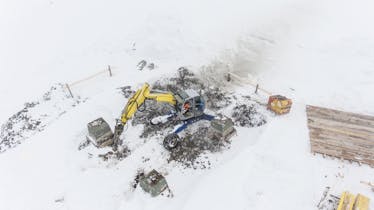At the end of October 2018, storm Vaia swept across Switzerland, causing massive damage. The Swiss transmission grid was also affected. On the summit of the Albula Pass in the canton of Graubünden, four masts were knocked over. They bear the 380 kV Filisur – Robbia lines as well as the Pradella – Robbia – Sils lines. This section between La Punt and Filisur was commissioned in 1968 by EGL AG.
The outage of both lines had no effect on the security of supply, neither in Switzerland, nor in the affected regions in the canton of Graubünden. Grid security was always guaranteed. The transit capacity to Italy was reduced, however.
The repair work began mid-April. In collaboration with the Canton of Graubünden’s civil engineering department, the Albula Pass road was cleared starting from La Punt first. In places, the plow had to work through metre-high snow.
Work completed on time
After the road was cleared, the individual mast sites had to be made accessible. After the old foundations were removed, new ones were created. It was possible to erect new masts upon them. After that, the insulators were suspended and the conductors installed. The work went according to plan. The lines have been operational since July 2019.
High safety requirements
Swissgrid has decided against erecting a temporary solution with emergency pylons. Safety concerns in particular contributed to the rejection of a temporary solution. At Swissgrid the «safety first» principle applies. The installation of emergency pylons in the wintry high mountain regions poses many risks to workers and materials. Furthermore, the window of opportunity would have been very close to the first big snowfall. Due to the winter weather conditions, in particular because of the snow and ice load and the danger of avalanche, the risk involved in the construction and operation of a provisional line would have been too high.
The conditions on the Albula were harsh: cold, snow, danger of avalanches and snow melt in early summer placed particularly high demands on the safety of the construction site.
Protection of the high alpine landscape
To protect the high alpine landscape, Swissgrid developed and executed a comprehensive environmental plan. It required helicopters to stay within defined corridors when travelling from the road directly to the pylon work sites, for example. Construction equipment was driven to the work sites one time only and, once there, moved as little as possible. Soil layers were removed and stockpiled separately and were then placed back in their original locations once the foundation work was done. Nature was then restored to its original condition as much as possible.







